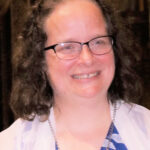By Barb Arland-Fye
The Catholic Messenger
DAVENPORT — Fifth-grader Noah Newberry of All Saints Catholic School won the Black History Month Essay competition, a collaborative effort of All Saints and St. Martin de Porres Society of Sacred Heart Cathedral. Runners’ up were fifth-graders Natalie Turner and Hugh Thompson.

Noah’s essay on baseball legend Jackie Robinson appears at right, and may be viewed on The Catholic Messenger website (www. catholicmessenger.net) along with the runners’ up essays.
Jim Collins, president of the St. Martin de Porres Society, said the essay competition began three years ago at All Saints in response to presentations he makes each February during Black History Month at the school. The cathedral is a feeder parish for All Saints.
“The students in the first couple of years of the presentations were very interested and were doing some research on their own, recognizing it was Black History Month. Our society thought that maybe we could encourage more research on their part with an essay competition,” Collins said.
All Saints fifth-grade teacher Eileen O’Brien, a member of the St. Martin de Porres Society, said she’d be glad to have her students write essays on a famous African American for Black History Month. Her interest in African American history dates back to a National
Endowment for the Humanities class she was selected to attend in Montgomery, Ala. She attended other programs after that.
“I was having students write about famous African American persons even before the contest,” she said, adding that the contest dovetailed beautifully with her interest and what her students were learning.
St. Martin de Porres Society received a total of 30 essays from the two fifth-grade classes at All Saints. The school provided a rubric for judging that addressed, among other things, why the student chose the person profiled and the impact that individual made.
“The judges’ job was made most difficult as several essays were of top quality and many others of high quality,” Collins noted. And, “even though we are knowledgeable about quite a few of the figures that students choose for their essays, we learn, too.”
O’Brien said she takes to heart what Evelyn Edelen McGrath, a daughter of the founder of Sacred Heart’s St. Martin de Porres Society, once told her. “I would hope that people would try to celebrate African American people throughout the year.” O’Brien does that. For example, her students celebrate Jackie Robinson Day in April and the anniversary of Brown v. the Board of Education victory in May.
WINNING ESSAY:
Jackie R. Robinson, by Noah Newberry
Jackie Roosevelt Robinson was born January 31, 1919. He was given the middle name of Roosevelt after President Teddy Roosevelt because he was brave and Jackie’s mom wanted Jackie to be brave, too. Jackie had three brothers and one sister. Jackie’s family was the only African American one in the neighborhood. One time a neighbor threw rocks at him.
As a child, Jackie loved to play sports! Any sport! Swimming did not make Jackie happy. African Americans were only allowed in the pools on Wednesdays from 2-5 p.m. That was not fair, but Jackie said that some things were fair and some were not. Jackie went to college at UCLA. He played a lot of sports and was one of the best athletes in the country. He got drafted into the army. After the army, no matter how good he was in sports he could not play with the white people.
There was a Negro Baseball League and Jackie played so well that Branch Rickey, president of the Brooklyn Dodgers, drafted him into Major League Baseball. Rickey said enough of this and it is time to do the right thing. Not only was Jackie the best African American player, he had a good attitude. Rickey warned Jackie that people would throw baseballs at his head and be mean. Jackie was scared but he wanted to play. He hit a home run in his first game! Jackie turned out to be one of the best baseball players ever!
When Jackie played professional baseball he did not lose his temper and he was kind. He played his best and he played with pride every single game. He played for all African Americans. He taught people how to play their best.
I think Jackie Robinson was and is a good role model. I like Jackie Robinson because he was a great baseball player. I love baseball and he makes me want to be a better player. Jackie played baseball with dignity and he proved he was brave.
“A life is not important except in the impact it has on other lives.” — Jackie Robinson
RUNNERS’ UP
Unsung Heroes by Natalie Turner
Now, you probably know Martin Luther King Jr., Jackie Robinson ,Rosa Parks, and Harriet
Tubman. But you might not know other hidden figures in America’s past that had a huge impact
on its’ future. Mary Louise Smith and Katherine Johnson are two of those types of people. This
essay will focus on them and their contributions and how their actions have influenced me.
Mary Louise Smith was born in 1937 in Montgomery, Alabama. On October 21, 1955 an 18
year old Mary on her way home on the bus was told to give her seat to a white passenger. She
refused and was sent to jail! Mary was the first African American to protest the white only
policy on buses, she was before Rosa Parks. She, like many others, stood up for their rights, and
were prosecuted. Most have been lost to history, but they remain as hidden figures. I’m glad that
just by the touch of a button we can remember these people! Mary’s courage to stand up for
what is right inspires me to stand up for myself.
Katherine Johnson is another amazing woman that inspires. She was born in 1918 in White
Sulphur Spring, West Virginia. Katherine went to West Virginia State University and received
her B.S. degree in mathematics and French in 1932. In 1953 she joined Langley Research
System as a research mathematician for National Advisory Committee for Aeronautics (NACA).
She was assigned to an all male flight research division. Katherine’s knowledge and expertise
made her useful and invaluable to her bosses and her leadership won her a spot in all white male
meetings. Some great achievements while at NACA and NASA, she calculated the flight path
for Alan Shepard, did the math for John Glenn’s orbit around the Earth in 1959, and Apollo’s
II’s flight to the moon in 1969. She retired in 1986 after 33 years of service. She has been
awarded many of the nation’s top honors.
These women are outstanding, intelligent, and brave! They inspire me to become an engineer
or a teacher and to stand up for my rights!
St. Martin de Porres by Hugh Thompson
Martin was born in Lima, Peru on November 9, 1579. He was the son of John
de Porres and Anna. His father was a Spanish knight, and his mother was a freed
slave. No one knows if Anna was from Africa, Panama, or Native American decent.
Martin was of mixed-race, and was teased for this. His parents were not
married. His father left his family and they were very poor. His mother sent him
away to a barber/surgeon.
In Peru, descendants of Africans or Indians weren’t allowed to enter
the religious order. So, he asked to be a volunteer with the Dominicans of the
Holy Rosary. He was allowed to wear the habit and live with them. He had to
do the most menial chores. When he was 15, he entered the Dominican Convent in
Lima. He was a servant boy and worked his way up to the church office where he
handed out money to the poor. He was a cook, cleaner, launderer, and healer.
After 8 years he was allowed to take vows and enter the Third Order of St.
Dominic. The prior, Juan de Lorenzana, disregarded the law that would have
forbidden Martin from entering the order. But, others weren’t as nice
about it. They teased him about being illegitimate and coming from a slave.
He was 24 years old when he became a Dominican Lay Brother. When he
was 34 he was assigned to the infirmary. He used his skills as a great healer.
He became known for his compassion and healing of all people, regardless of
wealth, or race.
He died November 3, 1639. He was canonized on May 6, 1962.
I’ve learned not to judge others based on their looks, or what they have.
Martin was determined to follow God’s call. I have learned to go for my goals.
He was the first black saint in the Americas. I think St. Martin de Porres is a
good role model for all people.











